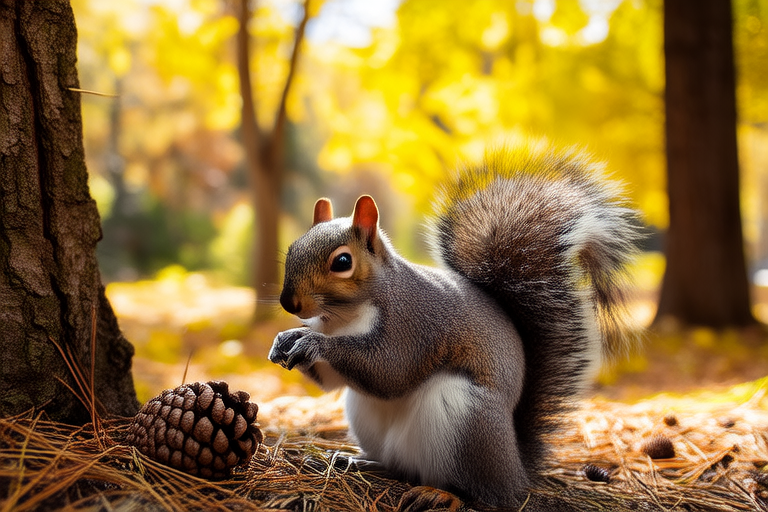How Squirrels Prepare for Winter: Nature’s Ultimate Preppers
Squirrels are one of the most ubiquitous creatures in North American forests, city parks, and suburban backyards. These small mammals are often seen scurrying about, gathering nuts and seeds with great precision. But what many people don’t realize is that these seemingly simple actions are part of a complex survival strategy that has evolved over millions of years. In this article, we will explore how squirrels prepare for winter, showcasing their remarkable ability to adapt and thrive despite harsh conditions.
The Food Cache: A Strategic Reserve
One of the most well-known traits of squirrels is their habit of caching or storing food. This behavior is crucial for their survival during the lean months of winter when food sources become scarce. Squirrels engage in two main types of caching: larder hoarding and scatter hoarding. Larder hoarding involves storing large quantities of food in a single location, such as a tree cavity or underground burrow. Scatter hoarding, on the other hand, involves spreading food items across numerous locations.
Recent studies have shown that gray squirrels, for example, can remember the location of up to 9,000 cached nuts! This impressive memory is facilitated by the hippocampus, a region of the brain responsible for spatial memory. The hippocampus in squirrels is particularly large compared to other small mammals, which allows them to navigate their environment with exceptional accuracy. This adaptation is critical for finding cached food, especially in areas where food is spread out.
Interestingly, squirrels also employ deception as a survival tactic. They sometimes create false caches by digging holes and pretending to bury food. This behavior confuses potential thieves, such as other squirrels or birds, who might otherwise pilfer their stash. By doing so, squirrels increase the likelihood of recovering their hidden treasures during winter.
Nest Building: A Cozy Retreat
Another essential aspect of squirrel preparation for winter is nest building. Nests provide protection from the elements, predators, and extreme temperatures. Squirrels construct two types of nests: dreys and dens. Dreys are typically built high in trees and consist of twigs, leaves, and moss. Dens, on the other hand, are located within tree cavities or abandoned bird nests.
The construction of a drey begins with the selection of a sturdy branch, usually near the trunk of a tree. The squirrel then gathers materials such as twigs, leaves, and moss, weaving them together to form a strong, insulated structure. Inside, they add soft materials like fur, feathers, and grasses to create a cozy sleeping area. The walls of the drey are thick, providing excellent insulation against cold winds and rain.
Research has demonstrated that the design of a squirrel’s nest can significantly influence its chances of survival during winter. Scientists have found that nests with higher insulation values tend to host healthier squirrels, as they maintain body heat more efficiently. This underscores the importance of proper nest construction in ensuring the survival of these animals.
Physical Adaptations: Built for Survival
In addition to behavioral adaptations, squirrels possess several physical traits that help them endure winter. One of the most notable is their thick fur coat, which grows thicker and longer during autumn. This increased density provides better insulation against the cold. Moreover, the fur color of some species changes with the seasons, blending in with snow-covered landscapes, offering camouflage against predators.
Another important adaptation is the squirrel’s metabolism. During winter, squirrels enter a state called torpor, where their body temperature drops and metabolic rate slows down. This allows them to conserve energy and survive periods of food scarcity. Torpor is different from hibernation, as it is a short-term state lasting only a few hours each day. This adaptation helps squirrels maintain their body temperature without expending too much energy.
Additionally, squirrels have powerful hind legs and sharp claws, which enable them to leap long distances and climb trees with ease. These physical attributes are vital for accessing food sources and escaping danger. Their agility and strength allow them to navigate their environment efficiently, increasing their chances of survival.
The Role of Squirrels in Ecosystems
Squirrels play a significant role in maintaining healthy ecosystems. By caching seeds and nuts, they contribute to forest regeneration. Many of the seeds they store remain uneaten and eventually germinate, leading to the growth of new trees. This process is known as seed dispersal and is crucial for the diversity and resilience of forest ecosystems.
Furthermore, squirrels serve as prey for various predators, including birds of prey, foxes, and snakes. Their presence in an ecosystem indicates a balanced and healthy environment. The decline in squirrel populations could lead to cascading effects on other species and the overall health of the ecosystem.
A Call to Action: Appreciate and Protect Local Wildlife
As we have seen, squirrels are highly adaptable creatures with a range of fascinating strategies for surviving winter. Their caching behavior, nest building, and physical adaptations demonstrate the incredible complexity of life in nature. However, despite their resilience, squirrels face threats from habitat loss, climate change, and human activities.
We can all play a role in supporting conservation efforts by appreciating local wildlife and taking steps to protect their habitats. This could involve planting native trees and shrubs, reducing pesticide use, and supporting organizations dedicated to wildlife conservation. By doing so, we ensure that future generations can enjoy the beauty and wonder of nature, just as we do today.
Let us take a moment to observe and appreciate the squirrels in our own neighborhoods. Their industriousness and adaptability serve as a reminder of the intricate balance of life in nature. By fostering a deeper connection with these creatures, we can inspire others to care for the environment and work towards a sustainable future.
